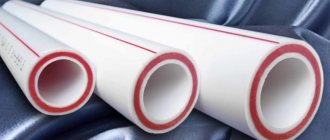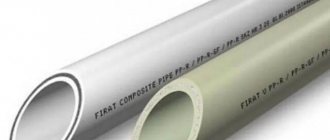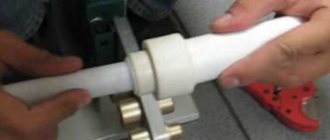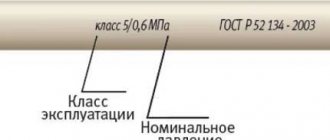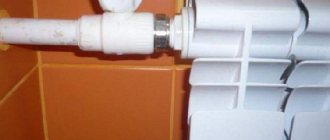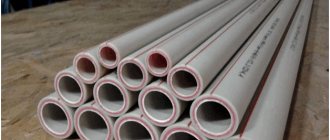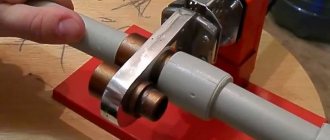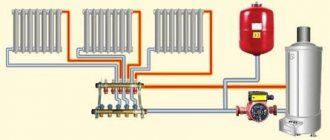Plastic pipes have long been an excellent alternative to metal products. This popularity is explained by the strength and durability of polymer materials. In addition, polypropylene pipes have a composite structure, which allows the material to withstand high temperatures and pressure (without deformation), not be subject to corrosion, and not react to aggressive components.
In addition, the installation of such pipelines is much simpler: the plastic is easily processed and heat welded. In this article we will look at the key parameters that will be useful to both the home handyman and the professional plumber.
What determines the choice of diameter
The choice of diameter of the PP pipeline depends on:
- purposes of application;
- pressure forces;
- workload;
- number of water sources.
As a rule, the inlet pipe has a diameter of 32 mm. For wiring, PPT 16-20 mm is used. Moreover, the internal diameter of the pipes directly depends on the thickness of their walls, so this parameter is one of the most important when installing a water supply system. For the most accurate representation, there is a special correspondence table.
Diameter of polypropylene pipes table:
For plumbing systems, pipes with an outer diameter of 21 to 25 millimeters are most often used, which is similar to standard steel pipes with a diameter of ½ and ¾ inches. For risers, products with a diameter of 32 to 40 millimeters are used.
There are several types of diameters among polypropylene pipes:
- 16-1200 mm;
- 16-32 mm in the case of household products;
- 40-50 mm for internal sewerage.
The maximum possible pipe diameter is 110 mm. However, it is applied only in the case of arrangement of sewers in large apartment buildings.
The maximum pressure at which a particular polymer pipe can be used is indicated in the marking. For example, the inscription PN10 means that the product should be operated at a pressure of no more than 10 bar, PN20 - no more than 20 bar. In addition, the markings indicate the temperature in degrees.
Polypropylene tubes have a high expansion coefficient: when the temperature changes during the use of the line, the dimensions of the PPT change noticeably.
The internal diameter depends on the permeability of the water supply. The following factors influence the level of cross-country ability:
- internal cross-section (the smaller it is, the weaker the flow);
- total pressure inside the system;
- deposits inside the pipes (depending on the service life of the product);
- number of transitions, turns and joints;
- composition of raw materials PPT (with a smoother surface, pressure and permeability will increase);
- total length of the pipeline (with a large length, the permeability decreases).
The diameter and wall thickness directly depend on the purpose of use and the class of the pipe. To find out the exact diameter, there is a special calculation based on the measurement of hydraulic parameters. The main purpose of this calculation is to obtain the most accurate diameters.
During the calculation, all aspects must be taken into account, including the system structure and operating pressure. For example, pipes for a heating system differ significantly from products for cold water supply. In most cases, for trouble-free operation of the main line without failures, it is necessary to use pipes with a large cross-section, which will increase costs several times. If you ignore the need for a large cross-section, the pressure will noticeably decrease.
Physico-mechanical characteristics
- Melting point: +149C (GOST 21553).
- Density: 0.9 g/cu.m. cm (GOST 15139).
- Yield strength (tension): from 24 to 25 N/kV. mm (GOST 11262).
- Tensile strength: from 34 to 35 N/kV. mm (GOST 11262).
- Elongation at yield point: 50%.
- Expansion coefficient: 0.15 mm/mmS (GOST 15173).
- Thermal conductivity (at +20C): 0.24 W/mS (DIN 52612).
- Specific heat capacity (+20C): 2 kJ/kgC (GOST 23630).
If you are setting up a house or apartment
When creating a project for a standard private house or apartment, there is no need to carry out precise calculations. The number of plumbing fixtures will be minimal, and the difference in price for pipes of different diameters will differ minimally, which will have virtually no effect on the budget.
If you look at the faucet hose, you can see what a small diameter they have, that is, through what minimal holes water flows into the sink. Taking into account the fact that the cross-section of the polypropylene pipe will be much larger, it will always be sufficient, since the bottleneck in this case will be precisely this hose. That is, the patency of the entire system will rest on its narrowest point.
That is why the owners of private houses and apartments do not carry out complex calculations, but simply purchase a polypropylene pipe with a cross-section of 20 mm, saving their precious time. In the vast majority of cases, with a standard number of washbasins, sinks, bathtubs and other plumbing fixtures, such a pipe will be sufficient with a large margin.
We hope everyone understands what diameter polypropylene pipes are measured by. Selecting them will not be difficult. As practice shows, you can often simply purchase the simplest and cheapest pipe - the result will be a high-quality and properly functioning water supply system.
How to properly secure a pipeline
Good heating or plumbing installation is not only about the quality of the connection, but also about the implementation of knowledge on how to install assembled polypropylene pipes.
Proper fastening of plastic wiring to the walls will prevent it from sagging and deformation when heated with hot water.
When making repairs, sometimes you have to forcefully pull the pipe out of the clips, so the dowels must firmly fix this small element against the wall
For fixing pipes, the following are used: clips (single, stacked, with a clamp) and clamps (on a hairpin, paired, wall).
New models are constantly appearing on the market, so it is better to select clamps and clips directly in the store. Clips basically ensure free movement of pipes along the axis, and clamps firmly fix them in one position.
A particularly dangerous consequence of improper installation is neglecting the thermal expansion of pipes.
The length of simple PP pipes can change by 10-15mm/1m when heated. When they are rigidly fixed, deformation occurs at the adhesions, which can lead to rupture of the connection. To relieve stress, the following types of compensators are used:
- Z-shaped;
- U-shaped;
- L-shaped
- ring.
Rules for working with a compensator:
After soldering the expansion joints and attaching the pipes to clamps and clips, you can begin testing the assembled system.
Types of plastic
Connection of plastic pipes.
Several types of plastic plumbing products are widely known. They are based on different types of chemicals:
- PVC pipes are produced based on polyvinyl chloride. Polypropylene pipes are marked with the letters PP, polyethylene pipes - PE, cross-linked polyethylene pipes - PEX. Metal-plastic ones are marked PEX-AL-PEX. PVC pipes are used for hot and cold water supply systems, sewage systems, and are used in the food industry. To connect them, special fittings are used;
- PP polypropylene pipes consist of a working layer, a foil layer and a protective layer, which are connected to each other thanks to perforated foil. Such layered structures have a diameter of 16-125 mm. They are connected by thermoplastic welding. They are used in drinking water supply systems, heating pipelines and compressed air transmission;
- PEX pipes are made using cross-linked polyethylene. They have high strength. Used for installation of heating and water supply systems. Mounted using compression fittings. They are used in snow melting systems and for the installation of heated floors;
- widespread metal-polymer pipes have an additional layer of aluminum foil inside. This layer allows you to significantly reduce the coefficient of linear expansion of the product. When bent, they retain their shape.
Polypropylene pipes are usually supplied in lengths of 4 m and are equipped with fittings. Fittings include tees, adapters, bends, combined couplings, American fittings, flange collars, combs, electric welded couplings, water sockets, crosses and plugs.
Diameters of polyethylene pipes.
The next indicator is diameter. It can be external and internal. Polypropylene pipes are produced with an internal diameter of 5 mm or more. This indicator allows you to calculate the amount of substance that can pass through the pipe per unit time. The outer diameter must be known to prepare a niche for laying the pipeline. for selection of connecting fittings.
- small diameter pipes - from 5 to 75 mm. They are used for installation of water supply and heating systems in private houses and apartments. The most popular in multi-storey residential buildings is the diameter of 32 mm;
- average diameter – 80-315 mm. They are used for sewerage systems, water supply in houses, for transporting various chemical liquids;
- 400 mm and above belongs to the large diameter classification. Such pipes are used to supply large volumes of cold water and for installing ventilation systems. The wall thickness of various polypropylene pipes can be 1.9-18.4 mm. For heating systems, thick walls should be chosen.
Diameters have standard designations. When choosing a suitable diameter, you need to consider:
- interior. This is the main characteristic for the selection of connecting fittings;
- external – divided into small size – 5-102 mm; average – 102-406 mm; large – 406 mm or more. Sometimes the diameter may be indicated in inches.
Inner diameter is an important characteristic. This value helps to select the necessary pipes for the installation of a wide variety of heating systems in everyday life and in production. You can calculate it yourself using the formula: d=sqrt((3.14xQ)(vxdt)). The symbols represent:
- d – required internal diameter;
- Q – heat flow value in kW;
- V – average coolant velocity in meters per second;
- dt – temperature range;
- sqrt – square root.
Polypropylene pipes with a diameter of 110 mm are used in industrial environments. 63 mm - for transporting chemicals and compressed air, as well as for connecting to the boiler room in heating systems. 25 mm – for connecting radiators to a general heating system.
The risers of 5-story buildings are made from pipes 25 mm in diameter. For buildings of 9 or more floors, a diameter of 32 mm is used. In-house wiring is carried out with a diameter of 20 mm. Large diameter pipes are used to supply cold water to several houses. 500 mm or more is suitable for installing a main water supply system supplying water to an entire urban area.
Installation of polypropylene pipelines is carried out using a minimal set of tools. You will need:
- roulette;
- scissors for cutting polypropylene;
- welding electrical device;
- corners;
- couplings;
- taps.
Scissors can be replaced with a hacksaw. The standard welding device is equipped with a set of nozzles for welding polypropylene pipes with a diameter of 20 to 50 mm.
System planning
Due to the fact that PPR pipes do not bend, when developing a wiring diagram it is necessary to create as few detours and turns as possible. After all, they are all made using fittings, and they have a significant cost (compared to a pipe). Therefore, we try to optimize the wiring - make as few turns, detours and bends as possible.
Serial (Tee) connection
Installation of water supply from polypropylene pipes with serial connection of consumers (plumbing and household appliances) is used in small systems. Usually they have 5-6 connection points. With this arrangement of the water supply system, one pipe leaves the riser and it sequentially bypasses all connection points. In the case of PPR plumbing, all branches are made using tees, which is why this type is also called tee.
Installation of water supply from polypropylene pipes with serial connection of consumers
The advantage of this system is that a small number of pipes are needed, and the disadvantage is that the pressure on each branch drops. As a result, with one or two working disassembly points, the third, located further from the riser, may simply not have enough pressure.
Parallel (collector) wiring
A parallel connection circuit is also called a collector circuit. This is because after the outlet from the riser, a special device is installed - a collector. This is an element with one input and a number of outputs. Available in polypropylene and metal. For water supply, polypropylene manifolds are more suitable (and cheaper).
The connection diagram is such that a separate pipe runs from each branch to each consumer (sometimes to a small group of consumers).
Parallel scheme for installing a water supply system from PPR pipes
The advantage of such a system is that the pressure at all water points is the same, the disadvantage is that a lot of pipes are required. Another plus is that if any branch fails, only one consumer does not work. The rest of the system is functioning normally. By the way, in order to be able to turn off individual devices, valves are installed at the outlet of the collector (usually ball valves, but if you need the ability to adjust the pressure, you can install a valve).
Plumbing and household appliances
In each method of installing a water supply system made of polypropylene pipes, a pipe is suitable for a specific consumer. There are two ways to connect to the system: flexible and rigid connection.
Rigid liner is more reliable: PPR pipes and fittings have high strength. Moreover, in this case there is only one thread - at the consumer connection point. But this type of eyeliner requires high precision: the error can be only a few millimeters. This is difficult to achieve when installing a polypropylene water supply with your own hands, so flexible hoses are often used. Just be careful, in some cases it is impossible to use it: connecting gas boilers or gas water heaters, supplying water to storage water heaters, water heated towel rails is recommended only using a rigid connection.
Rigid liner options
Soft eyeliner, on the contrary, does not require high precision - errors are leveled out by a flexible stainless steel braided hose or a hose that is used to connect a washing machine or dishwasher. The tubes are removed approximately in the area where the equipment is installed or the plumbing is connected. It ends with an adapter for metal, to which a flexible hose is connected (its other end is connected to the device).
Flexible hoses are connected to the adapters
This option is less reliable, since much depends on the quality of the flexible liner. Also not the most pleasant moment is the presence of two threaded connections, and this is a potential place for a leak to appear.
Diameters of polypropylene pipes correspond from external to internal
Polypropylene products differ from other types in their relatively low cost and ease of installation. In addition, pipelines made of this material are not subject to corrosion and deposits, do not conduct electricity, have an aesthetically attractive appearance and very rarely leak. If such a problem occurs, it is associated with errors made during installation.
In addition to indoor water supply and heating systems, polypropylene products are used in ventilation systems, sewage systems, external water supply pipelines, industry and agriculture.
Classification of polypropylene pipes:
- PPH is the first type, made from homopolypropylene, has increased strength, is used in cold water systems, ventilation, and industry
- PPB is the second type, made from a block copolymer, used in ventilation and cold water systems, as well as in heated floors
- PPR - the third type (the most common), made from random copolymer, used for cold and hot water, radiator and underfloor heating
- PPs are a special type that allows internal temperatures up to 95 degrees.
Polypropylene products are also divided into reinforced and non-reinforced. Aluminum foil or fiberglass can be used as reinforcement. The foil can be located near the outer surface or in the middle of the wall.
Diameters of polypropylene pipes: dependence of wall thickness
Before designing a pipeline, you need to know what diameter of polypropylene pipes will be used. There is a complex hydraulic calculation. His goal is to choose the right size for each plot in order to save money when purchasing. The calculation takes into account the operating pressure and structure of the system. A large cross-section, of course, will not harm, but it will be very expensive. If the cross section is too small, the pressure will decrease.
What diameters of polypropylene pipes are there? From 16 to 1200 mm! However, for domestic water supply and heating systems, products with sizes from 16 to 32 mm are used, for internal sewerage - 40, 50 mm or polypropylene pipes with a diameter of 110 mm. The maximum diameter of polypropylene pipes is relevant when installing external sewer pipelines for very large houses or entire neighborhoods.
When designing an internal cold water supply system, the choice of size depends on the length of the pipeline and the number of water supply points. The supply pipe most often has a size of 32 mm; for indoor distribution, the outer diameter of polypropylene pipes is 16 - 20 mm.
No less important is such an indicator as wall thickness. The internal diameters of polypropylene pipes depend on it. The table will help you understand the variety of sizes:
Key selection criteria
To buy high-quality pipes that will easily reach the service life declared by the manufacturer, you must follow the selection recommendations:
- Selection of components.
During installation, you will definitely need couplings, fittings, and wiring tees. The ideal option would be combined elements with threaded inserts or metal frames. Such products will provide a high-quality transition between plastic and metal pipes. - Manufacturer.
The products are in consistently high demand all over the world, so plastic pipes are produced by domestic, European and Asian companies. Pipes produced by German, Czech and Russian companies have proven themselves well. Products from Turkish and Chinese manufacturers should be treated with caution: low cost implies low quality.
- Marking.
Here you need to pay attention to the pipe capacity, resistance to water hammer and temperature changes. The best option is to choose a pipe whose characteristics slightly exceed the required values.
It should be noted that the durability of a plastic pipeline is affected not only by the characteristics of the product, but also by the correct installation.
Classification by cross-country ability
Additionally, pipes are classified according to permeability. The internal size of polypropylene pipes indicates how much water they can pass in a certain period of time. The external dimensions of the PP pipe in this case do not matter. This suggests that the wall thickness can be any - only how strong the pipes will be depends on this parameter.
How to correctly calculate pipe patency
To calculate the internal diameter of PP pipes, you need to use the following formula:
D = √(4 - Qtotal - 1000/π∙V), where:
Qtotal – maximum total water consumption;
V – speed of water movement.
If the pipes are thick, then the speed is assigned a value of 1.5-2 m/s, but for thin pipes this value is usually equal to 1.2 m/s. That is, the smaller the pipe cross-section, the higher its surface/lumen ratio. In other words, in a thin pipe, almost the entire volume of water will slow down against the walls.
PP pipes with sections of 10-25 mm are selected if the water movement speeds are low. But if the V values are large, then the pipe cross-sections must be at least 32 mm.
In any case, it is advisable to proceed from the highest speeds, since polypropylene has very smooth walls. If a water supply system is installed, then in this case the friction of water on the inner surface of the pipes will be minimal.
The exact values of the permeability and cross-section of pipes are of great importance only in the case of designing a water supply system in multi-storey buildings. If you do not use the table of polypropylene pipe sizes and choose a pipe with a cross-section smaller than the required one, then during periods of peak water consumption, residents will simply be left without water.
However, you may want to take a pipe with a spare cross-section
In this case, it is worth paying attention to the feasibility of such a decision from an economic point of view. Larger diameter pipes will require more expensive fittings
As a result, costs may increase significantly. If you wish, this can be prevented, the main thing is to use a rational approach.
It is not advisable to use PP pipes of large cross-sections in places where thin pipes would be sufficient, again for the purpose of economy. The fact is that when you drain cold water from a tap for a long time, with a larger cross-section of pipe and water, more will be spent before the water becomes hot. If there is no water intake, then a significant part of the heat from hot water will simply dissipate idle.
It is recommended to organize a circulating water supply system, so you will not need to drain the water every time it gets hot. If this is a private house, then you only need to install a simple circulation pump, as well as purchase and equip the system with an additional pipe through which the water will return to the boiler.
There is a huge range of polypropylene pipes on the market for heating and more. If you are making a water supply riser, then polypropylene pipes with a cross-section of 25 mm are suitable if it is a five-story house, and 32 mm for houses from nine to sixteen floors. In this case, when deciding on the diameter, it is worth taking into account the exact number of plumbing fixtures that will be used in this system.
Large cross-section polypropylene pipes are most often used to supply cold water to one or more houses. Polypropylene is not used for laying pipes in heating mains, as it does not like hot water. In addition, this is a place where the pipes will be subject to a large load, which can simply damage the soft polypropylene.
With cold water, everything is much simpler - due to its low temperature and low pressure in the system, cast iron is increasingly being abandoned in favor of polypropylene when installing water pipelines. Quite often you can find systems with a nominal diameter of polypropylene pipes of 500 mm or more, which supply entire small areas.
A few recommendations
Plan where and how the pipeline will run. Count the required number of pipes, angles, tees, and adapters. Take into account where the pipes will cross. Buy corner fittings and pipes with some reserve: during the installation process it may be necessary to change the pipeline path. After completing installation, be sure to check the finished pipeline under pressure for possible leaks.
Proper installation will allow you to forget about problems with your plumbing for the next 50 years.
The ratio of the bore diameters of pipes made of different materials. Sample Pivot Table
Very often, installers and mechanics confuse pipe diameters. I had to see how a mechanic from the housing office insisted that during the alteration the diameter of the pipes in the central heating should not be narrowed, while demanding that everything be passed through as 25 metal (34), but the installers understood this as 25 polypropylene.
Do not forget that in pipes it is the internal diameter that is important, because it determines their throughput.
Below is an approximate summary table of pipes of different diameters and different materials. The most common materials and diameters are taken.
How to use the table: on the left, the vertical column shows the internal diameter, for example, we find 15.6 mm, this internal diameter corresponds to a regular steel pipe 12. PN10 polypropylene with a diameter of 20 mm, 20 mm metal-plastic and 18 mm copper.
By the way, an ordinary pipe in 34 corresponds to polypropylene PN20 with a diameter of 32 mm, which is considered to be inch.
Polypropylene and metal-plastic pipes using information about Wavin pipes from 20 to 40 mm in diameter
Copper pipes were used according to GOST 2005, up to 15mm diameter the wall thickness was 0.8mm, up to 28mm the wall thickness was 1mm, over 28 -1.2mm
The steel pipes used are old GOST from 1975.
Uponor-PEX polyethylene pipes with pressure up to 10 bar for heating and plumbing.
Pipes that are very similar in internal diameter are combined under the closest value.
Perhaps such a table will be useful in calculations.
Polypropylene pipes and their main diameters
Previously, only cast iron and galvanized steel pipes were used for the installation of various pipelines. They were replaced by products made of polypropylene. They differ from cast iron in their high degree of reliability, lightness, durability, and low cost. Polypropylene pipes do not conduct electricity. This quality makes them indispensable when connecting washing machines. The completely smooth inner surface prevents debris from accumulating inside them.
Advantages of plastic pipes: durability, anti-corrosion resistance, low thermal conductivity.
Polypropylene has high anti-corrosion resistance. These pipes can transport gas and chemical liquids. Polymer materials are not afraid of temperature changes. They do not burst from freezing in winter and are able to withstand high temperatures. Craftsmen assemble frames for gazebos and greenhouses from such products. The diameter of polypropylene pipes varies. The properties and areas of application of these products largely depend on it.
Some important installation nuances
The installation of plastic pipes is somewhat different from their metal counterparts. In particular, during installation the following conditions must be observed:
- Polypropylene pipes do not bend at right angles; tees and fittings are used here to change the direction of the line.
- Plastic does not collapse under the influence of temperature changes: the pipe increases in length. Therefore, if the length of the pipeline section exceeds 10 meters , temperature compensators must be installed.
- Under the influence of high temperatures, pipes are subject to linear expansion, so rigid fixation of the pipeline inside wall structures is not allowed: thermal gaps must be left.
- For hot water supply, only reinforced products are used, which are less susceptible to linear expansion.
- Slight bending of the pipe is allowed. This can be done by heating the surface with a hair dryer (temperature about 140 degrees ).
It should be noted that storing plastic pipes in open spaces is not recommended. To protect products from direct sunlight, which destroys the structure, canopies must be installed.
How to choose the right diameter for your home line
For polypropylene pipes that will be used in apartment buildings, all calculations of the main line for water supply and sewerage must be made with great care and attention. Accordingly, the higher the water consumption by residents, the larger the diameters of polymer products are used
As a rule, in apartment buildings the following sizes of polypropylene pipe diameters in mm are used:
- for risers of 5-storey buildings Ø25 mm;
- wiring inside buildings – Ø 20 mm;
- for risers of houses of 9 or more floors, PPT Ø 32 mm is used.
For each specific apartment or private house, there is no need to accurately calculate the diameter of the water supply pipes, since there are not many intake points in such premises. In this case, the pipes are selected according to a given specification and have a cross-section larger than the diameter of the mixers.
The diameter of polypropylene pipes for water supply in an apartment or house is selected taking into account the following features:
- for pipeline lengths up to 10 m, the preferred diameter is 20 mm,
- for pipelines 10-20 m - diameter 25 mm,
- with a length over 30 m - diameter 32 mm.
For risers, choose products 32 mm or more.
If necessary, the calculation of a home pipeline can be done using a simple formula, which initially only requires the exact value of water flow and the total speed of the internal fluid flow. We select the internal diameter of polypropylene pipes by basic calculation with the initial data:
- speed of fluid movement along the line;
- water consumption.
The diameter of polypropylene pipes for water supply to an apartment or private house is calculated using the following formula:
In apartments and houses, it is recommended to install heating pipes with a clear diameter of 20 mm, and for a water supply system, the minimum cross-sectional size should be 16 mm. Do not exceed this size to avoid losing compliance with specifications. As for pipes with the largest possible diameter (over 500 mm), there is no need for them at all.
Based on everything described above, you can easily decide on the choice of polypropylene pipe for water supply in each specific case, and make an independent calculation of its diameter, based on a simple formula and data from the table.
Recommendations for choosing polypropylene pipes or how to choose the right size
Special calculations will help us in choosing the pipe size, for which we need to know the flow rate of the working medium and the speed of its movement. There are several general schemes with which you can choose the correct diameter. For arranging a sewer system, for example, the table below is suitable:
| Diameter, mm | Filling | Acceptable (optimal slope) | Speed of movement of waste water in the pipe, m/s | Consumption, l/sec |
| 100 | 0,6 | 0,02 | 0,94 | 4,6 |
| 125 | 0,6 | 0,016 | 0,97 | 7,5 |
| 150 | 0,6 | 0,013 | 1,00 | 11,1 |
| 200 | 0,6 | 0,01 | 1,05 | 20,7 |
| 250 | 0,6 | 0,008 | 1,09 | 33,6 |
| 300 | 0,7 | 0,0067 | 1,18 | 62,1 |
| 350 | 0,7 | 0,0057 | 1,21 | 86,7 |
| 400 | 0,7 | 0,0050 | 1,23 | 115,9 |
| 450 | 0,7 | 0,0044 | 1,26 | 149,4 |
| 500 | 0,7 | 0,0040 | 1,28 | 187,9 |
| 600 | 0,7 | 0,0033 | 1,32 | 278,6 |
| 800 | 0,7 | 0,0025 | 1,38 | 520,0 |
| 1000 | 0,7 | 0,0020 | 1,43 | 842,0 |
| 1200 | 0,7 | 0,00176 | 1,48 | 1250,0 |
Temperature can be calculated using this table:
| Pipe diameter, mm | Bandwidth | |||
| By warmth | By coolant | |||
| Water | Steam | Water | Steam | |
| Gcal/h | tons/h | |||
| 15 | 0,011 | 0,005 | 0,182 | 0,009 |
| 25 | 0,039 | 0,018 | 0,650 | 0,033 |
| 38 | 0,11 | 0,05 | 1,82 | 0,091 |
| 50 | 0,24 | 0,11 | 4,00 | 0,20 |
| 75 | 0,72 | 0,33 | 12,0 | 0,60 |
| 100 | 1,51 | 0,69 | 25,0 | 1,25 |
| 125 | 2,70 | 1,24 | 45,0 | 2,25 |
| 150 | 4,36 | 2,00 | 72,8 | 3,64 |
| 200 | 9,23 | 4,24 | 154 | 7,70 |
| 250 | 16,6 | 7,60 | 276 | 13,8 |
| 300 | 26,6 | 12,2 | 444 | 22,2 |
| 350 | 40,3 | 18,5 | 672 | 33,6 |
| 400 | 56,5 | 26,0 | 940 | 47,0 |
| 450 | 68,3 | 36,0 | 1310 | 65,5 |
| 500 | 103 | 47,4 | 1730 | 86,5 |
| 600 | 167 | 76,5 | 2780 | 139 |
| 700 | 250 | 115 | 4160 | 208 |
| 800 | 354 | 162 | 5900 | 295 |
| 900 | 633 | 291 | 10500 | 525 |
| 1000 | 1020 | 470 | 17100 | 855 |
You should be careful with it, since a breakthrough of boiling water means not only a pipe breakage, but also possible injuries. If you have little experience in purchasing polypropylene pipes, it is better to use the following methods:
- Find suitable GOSTs that contain detailed installation requirements.
- Use a calculator. Online calculators are not always able to take into account all the nuances due to their simplicity. To do this kind of work, there are companies that can help you choose.
- Contact a specialist in a specialized store. There may well be people there who are knowledgeable about pipe sizing. If there are no such stores in your locality and everything is ordered online, you can try to clarify all questions via the Internet with qualified specialists.
Where are polypropylene pipes used?
Polypropylene pipes appeared on sale not so long ago, however, they are already very popular.
There are a number of advantages that set them apart from their analogues:
- the material is not subject to oxidation;
- can be used in environments with aggressive conditions;
- low cost;
- do not conduct electric current;
- pipes are easy to lay;
- look great in appearance.
It is worth noting that PP pipes can be used not only as internal water supply.
Additionally, they can be used to arrange:
- Ventilation systems. Even the large outer diameter of polypropylene pipes makes them lightweight, without creating large loads on partitions made of wooden frames and plasterboard sheathing, for example.
- Sewers. The material is not afraid of aggressive substances.
- External water pipes with cold water supply.
Since polypropylene is not as durable as cast iron, it needs protection in some areas. If pipes are laid under roads, it is better to build a reinforced concrete box.
The advantages include the fact that deposits do not accumulate on the inner walls of polypropylene pipes. Due to their elasticity, such pipes will not be damaged by frost.
Types and purpose
Polypropylene pipes can be single-layer or three-layer. Single-layer ones are used for water supply, sewerage, ventilation and other pipelines with the temperature of the transported medium not exceeding +45°C.
Three-layer PPR pipes are reinforced. Reinforcement is designed to reduce the amount of thermal expansion and nothing more. PPR pipes are reinforced with fiberglass and foil. Those with glass fiber are suitable for hot water supply, provided that the water temperature is not higher than 80°C. For heating and systems where water can heat up above 80°C, foil-reinforced polypropylene is used. The foiling may not be continuous. For such pipes, the permissible temperature of the transported medium is +95°C.
Color is just a dye. It does not affect the properties in any way.
Can polypropylene pipes be used in underfloor heating systems? I guess, yes. The coolant temperature does not rise above +45°C, which is quite acceptable even for single-layer ones. But due to high thermal expansion, PPR pipes for heated floors are not the best option, even those reinforced with foil. There are more stable options and not more expensive.
Types of polypropylene pipes
Polypropylene pipes are divided into types according to the composition of the raw materials and the pressure at which they are used.
Classification of polypropylene pipes (PPP) according to the composition of raw materials, namely the degree of modification of the main polymer with various additives used:
- PPR (PPRS, PPR) - pipes of this type are made from a static copolymer of polypropylene foam with a crystalline molecular structure. These products are resistant to temperature fluctuations from -170 to +1400C, as well as shock loads, so they are often used for plumbing, heating and sewage systems. Diameter sizes from 16 mm to 110 mm.
- PPH - in these products, to impart increased impact strength, modifying additives are mixed with polypropylene: nucleators, fire retardants, antistatic agents. This type with a large diameter is used for external water supply, drainage, and ventilation systems. But these products are not suitable for heating devices because they have a low melting point.
- PPB (block copolymer) - this type of raw material has a structure of blocks of homopolymer micromolecules, differing in composition and structure, which alternate with each other in a certain order. Ultimately, the products acquire an increased degree of impact resistance, which is why they are used for underfloor heating and cold water supply systems.
- PPs (polyphenyl sulfide) - this highest class of polymer with a special molecular structure has increased resistance to stress and overheating, is very wear-resistant and durable. PPs are used for cold and hot water supply, ventilation, and heating systems. The diameter of these polypropylene pipes varies from 20 to 1200 mm.
In this case, the configurations, as well as the external and internal diameters of polypropylene pipes are strictly regulated by GOST.
In the marking of polypropylene pipes, the designations N25, N 20, N10, etc. are found. This indicator allows you to evaluate the resistance of PPT to the pressure of the liquid that is in them.
There are these types of polypropylene pipes based on pressure, which determines what diameter to choose the product:
- РN10 (N10) – with a working pressure on the wall of 1.0 MPa and a polymer thickness from 1.9 to 10 mm. They are used for installing underfloor heating systems and cold water supply with heating up to +45 °C. The diameter of pipes of this type is: external – 20…110 mm, internal – 16…90 mm.
- PN16 - this type of product is rarely used, has a wall pressure of 1.6 MPa. Suitable for cold and hot water with heating of the coolant up to +60 °C.
- N20 (РN20) – products with a working pressure on the wall of 2.0 MPa and a thickness of 16...18.4 mm. The most popular polymer for hot and cold water supply with heating temperatures up to 80 °C. Version: outer diameter - 16...110 mm, inner diameter - 10.6...73.2 mm.
- N25 (РN25) – polypropylene with a working pressure on the wall of 2.5 MPa and reinforcement with aluminum foil. Ideal for installing hot water supply and heating systems with liquid temperatures up to +95 °C. The multilayer structure of these products contributes to high resistance to thermal and shock loads. The diameter of pipes of this type is 13.2...50 mm, outer diameter is 21.2...77.9 mm.
There are also fiberglass reinforced PPT. Such lines do not delaminate during operation, and when assembling a water pipeline, they save time on cleaning up cuts during welding. Polypropylene pipes reinforced with fiberglass mesh are resistant to deformation, have an extended service life, and provide quick and easy installation.
Methods for connecting pipes with fittings
How to choose a machine for welding polypropylene pipes
The basic method for installing pipes with polypropylene connecting elements is polyfusion welding. For this purpose, special soldering irons are used: disk or rod. The latter is used for butt welding of pipes and fittings with a diameter of more than 63 mm. Smaller components are connected using a disk soldering iron.
Paired nozzles are installed on the heating element on both sides. The parts of the pipe and fitting prepared for connection are heated simultaneously to a temperature of 260°C. Then the parts are connected and held in this position for 10-15 seconds. Underheating, as well as overheating of the area where welding will be carried out, leads to a defective weld.
Use of reinforcement
Reinforcement is one of the ways to give pipes special mechanical properties.
Reinforcement is as follows:
- Aluminum foil layer. It can be either external or located internally.
- Fiberglass layer. As a rule, it has an internal location.
Thanks to the reinforcement, the pipes are more durable, and the amount of their thermal expansion becomes smaller.
Experts recommend paying attention first of all to the fiberglass reinforcement layer. This type of pipe never loses its mechanical strength and does not delaminate, and its installation does not require stripping
This type of pipe never loses its mechanical strength and does not delaminate, and its installation does not require stripping.
Which PPR pipes are more convenient to install?
The easiest and fastest way to install, of course, is single-layer polypropylene pipes. For installation it is enough:
- cut the product with a hacksaw or pipe cutter,
- rub away burrs on the edges,
- connect structural elements using a fitting or special glue (liquid welding).
We recommend that you read: Replacing old pipes with polypropylene on your own
The principle of installing multilayer PPR pipes is the same, however, in this case cold welding is not suitable, since it will only glue the outer layers and will not provide a reliable connection.
Therefore, multilayer pipes are best connected by hot welding or using special multilayer threaded fittings.
Attention! Do not attempt to thread a pipe or fitting yourself. There is a high probability that the resulting threads will not match, which means the connection will not be airtight. It is better to buy fittings with ready-made standard threads.
Pipes with aluminum reinforcement require special preparation before installation. If layers of fiberglass pipes are literally soldered into each other, then aluminum foil is connected to polypropylene using glue, which means there is a possibility of delamination.
To avoid this negative consequence, before welding PPR pipes with aluminum reinforcement, it is necessary to remove a small section of foil and solder the inner and outer layers of polypropylene together. Thanks to this action, water will not be able to penetrate between the layers, which means there will be no threat of deformation and destruction of the pipeline.
Pipe classification
Installation of polypropylene pipe.
- PN 10. They have normal strength. These are polypropylene pipes with thin walls. The range of their application is quite wide. They are highly resistant to high and low temperatures. Can be used for installation of underfloor heating and plumbing systems. Their outer diameter is 20-110 mm, inner diameter is 16.2-90 mm, wall thickness is 1.9-10 mm;
- PN 20. This model is universal. Used for installation of ventilation and hot water supply systems. They can be used for underfloor heating systems. The inner diameter is 10.6-73.2 mm, the outer diameter is 16-110 mm, the wall thickness is 1.6-18.4 mm. In the cold they become fragile;
- PN 25. Polypropylene pipes, reinforced with aluminum foil or fiberglass. They are very durable. Used for installation of central heating systems, external water supply, high pressure air supply systems. Inner diameter – 13.2-50 mm, outer diameter – 21.2-77.9 mm, wall thickness – 4-13.3 mm.
The numbers 20, 10 and 25 indicate the maximum permissible pressure in kg/cm².
Material properties
Polypropylene is a kind of thermoplastic polymer. It is made by combining (polymerizing) molecules of the derivative gas ethylene. International designation of polypropylene “PP”. Let's take a closer look at the properties and manufacturing technology of this new generation material.
Possessing unique resistance to alkaline solvents and aggressive substances, the material is widely used in the installation of any plumbing structures. Withstands low and high temperature conditions, they can vary from minus 10 to plus 100 C.
Advantages
- durability. They last 3-5 times longer than steel and cast iron. Their service life is 50 years or more;
- anti-corrosion resistance. Polypropylene does not enter into electrochemical reactions;
- this plastic is a clean material from an environmental point of view;
- it has poor thermal conductivity. This prevents condensation from appearing on the surface of the water supply;
- The products are light in weight. It is 9 times lower than the weight of metal analogues;
- water movement occurs practically without noise;
- installation and installation of systems is extremely simple;
- they can be laid inside and outside the building;
- the internal parts of polypropylene pipes that are in direct contact with water fully comply with all sanitary standards of Russia, the USA, Germany, England, Belgium, Spain and Italy;
- their outer surface does not need painting.
The disadvantages of a polypropylene pipeline include:
- each type of polymer material requires the use of different installation technologies;
- they cannot be used for fire protection purposes;
- not all products can be used for installation of hot water supply and heating systems.
All polypropylene pipes are available in different colors. They come in white, black, gray and green. Color by itself doesn't mean anything. The exception is that black color protects somewhat better from ultraviolet radiation.
Tees, crosses
The main purpose of the products is to join/bend several pipe bends. They are characterized by different angles and configurations. In the case of a heating system, welded fittings equipped with a smooth internal threadless surface are well used. Less often, it may be necessary to switch to another type of material, then there are threads at the ends of the connections.
Transition tee
The use of a fitting is relevant when arranging a pipeline with a transition to a smaller diameter. The operating temperature is 95 degrees, the pressure is 2.5 MPa, the connection is provided by butt welding.
Combination tee with internal thread
The product is used for connections with reinforcing elements, faucets, plumbing fixtures or steel pipes in pipeline branch areas. Operating temperature 95 degrees, pressure 2.5 MPa, butt connection.
Male Tee
Used for joining PVC pipes with reinforcing elements and steel pipes when branching pipes.
Tees with union nuts
The design is used for dismountable threaded connections of PVC pipes with steel fittings or pipes when branching pipes in areas with cold or hot water supply. The maximum heating level is 80 degrees, pressure 2.0 MPa. The connection is formed using butt welding.
